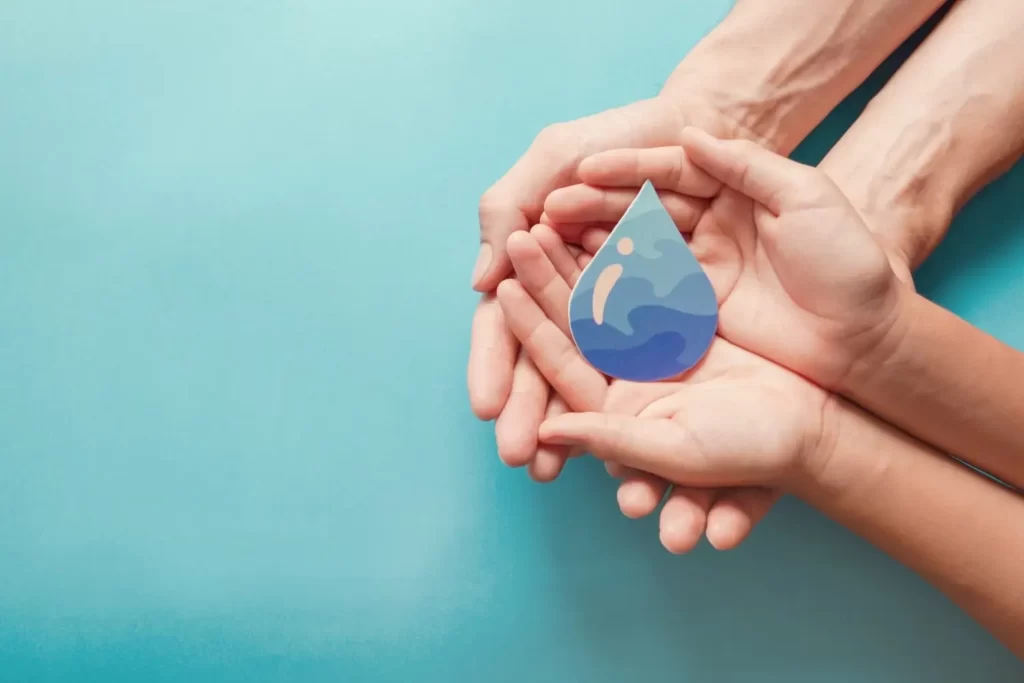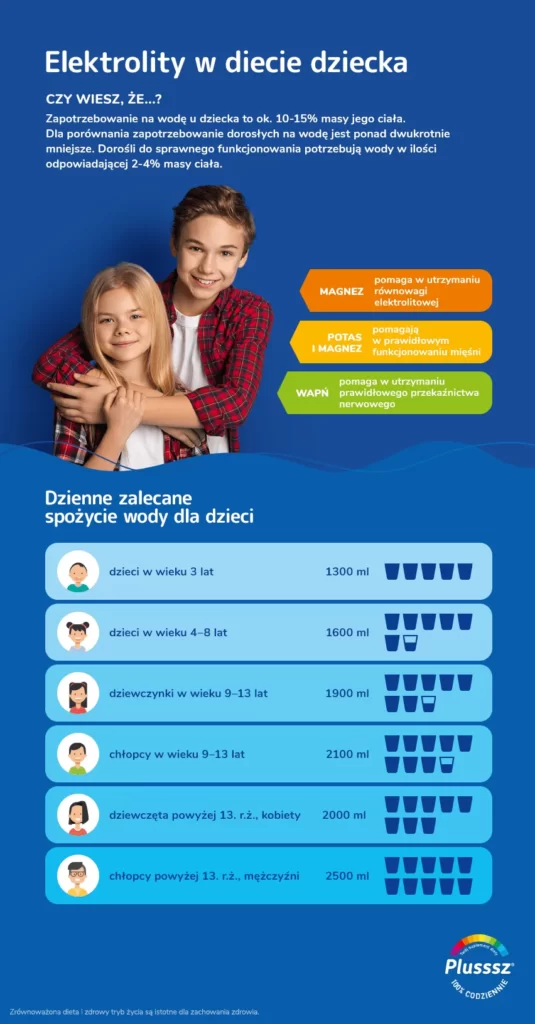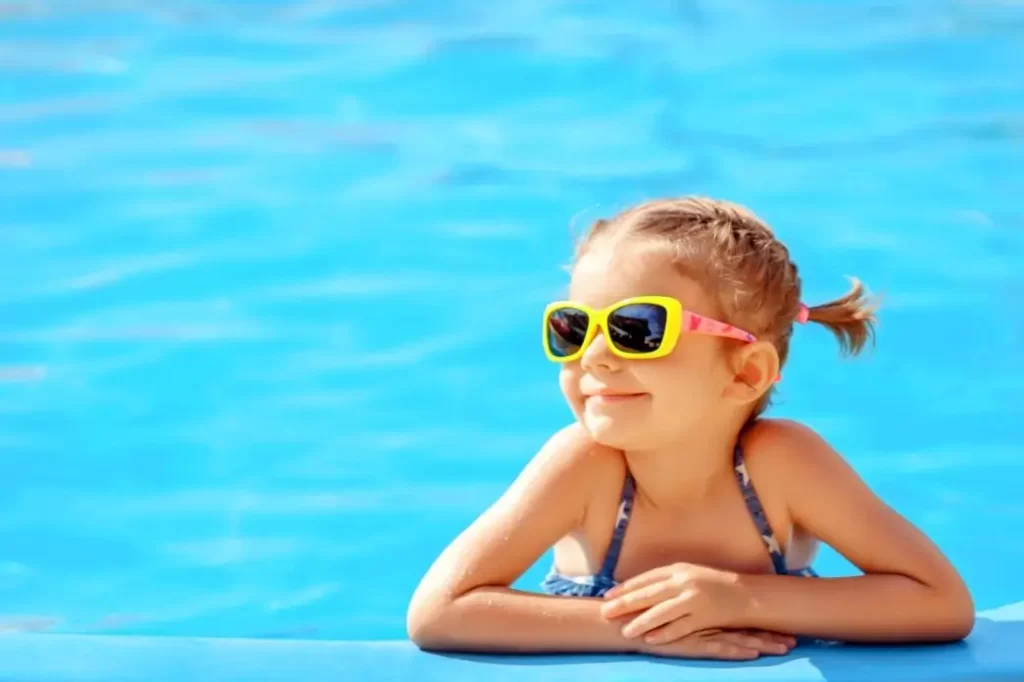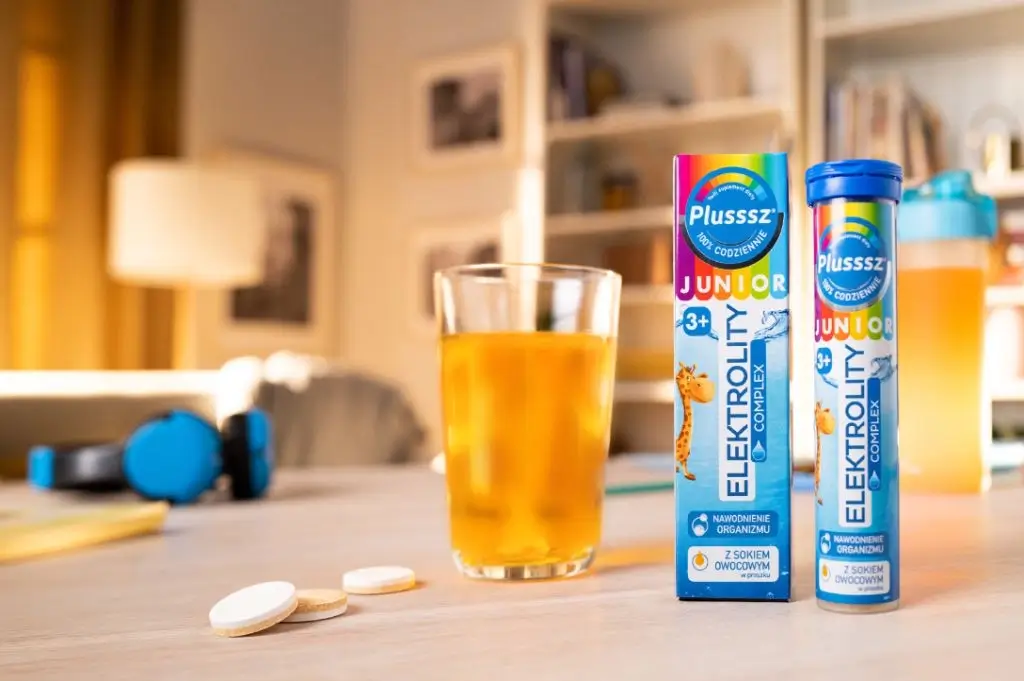Most children lead a very active lifestyle. The growing awareness of parents and the desire to provide their children with the best possible start into adulthood force caregivers to organize many activities for the youngest from the very first years of life.
Regardless of whether we are dealing with an early school child or a teenager, the intensity of learning and extracurricular activities is usually very high and often exceeds the full-time employment of an adult professionally.
In addition to school activities and the need to prepare for them (tests, quizzes, presentations, group and individual projects, art work and many others), children often take on additional sports or volunteer activities. How can you ensure their proper level of hydration, vitamin and mineral support and make them full of energy in such conditions?
How can you support young athletes and provide them with the best conditions for practicing the discipline they have come to love? By properly organizing classes, providing space for learning and supporting healthy eating, it is possible to achieve mastery in any discipline!

Fig. 1. Young athletes need special support in hydration after training.
Of course, the principle of “you are what you eat” also applies to children. In their case, taking care of a properly balanced diet is all the more difficult because they have their own preferences, which rarely go hand in hand with a healthy diet and proper hydration of the body.
What are electrolytes?
Electrolytes are a group of elemental ions that naturally occur in the human body and which, dissolved in water solutions, provide an environment for the proper conduction of electrical impulses throughout the body. Their correct level is essential for maintaining well-being and mental efficiency (they conduct impulses between brain cells – neurons).
Among the elements from this group, sodium, potassium, magnesium, calcium cations and chloride anion are distinguished – they affect various processes occurring in the heart, brain and muscles, and all together create an environment in which tissues and organs function efficiently and effectively.
Causes of improper hydration in children
Children are particularly susceptible to loss of water and sodium, potassium and magnesium cations, which together are the basic components of body fluids. Why are children so sensitive to a decrease in hydration levels? There are many reasons for this phenomenon. First of all, they should be sought in the structure of children’s bodies and their physiology. The younger the child, the more pronounced the symptoms of improper water and electrolyte levels in the toddler’s body may be.

Fig. 2. Children are more susceptible to a drop in body hydration than adults.
Children and the elderly are sensitive to symptoms of an incorrect level of hydration. As long as water and electrolyte components are replenished on an ongoing basis, an episodic drop in fluid levels does not pose a danger and does not negatively affect the child’s well-being.
The body releases water and electrolytes:
- During excretion – water loss is a natural process associated with metabolism and cleansing the body of metabolic waste products, e.g. urea.
- With sweat – sweating occurs even when the body is not exposed to additional, extreme effort, e.g. during sports or in the heat. Sweat glands work constantly, releasing small amounts of water and e.g. sodium. In a situation where sweating is not particularly intense, e.g. a child spends time at school or at home learning and having fun that does not require special physical effort, you may not even notice or realize that your little one needs hydration, because small amounts of sweat are wicked away by layers of clothing and evaporate from the skin surface unnoticed. If a child sweats heavily, e.g. after football training, as a result of exposure to high temperatures or emotional arousal, requires immediate replenishment of fluids – give them water or a portion of an electrolyte drink intended for children. A drink will hydrate the child more effectively than water, and can also be a good way to “smuggle” the right amount of healthy fluids into the diet of a child who may refuse to drink water alone due to the lack of taste.
- In hot weather – children, like older people, have problems with proper regulation of body temperature. They are particularly sensitive to overheating and may lose water more intensively than adults in hot weather. In addition, they often do not communicate discomfort appropriately, and while playing, they may not feel the discomfort associated with prolonged exposure to the sun or a hot, stuffy room.
A decrease in children’s hydration levels can occur in many seemingly completely ordinary and everyday situations. When?
- During intellectual effort – many hours spent at school and in extracurricular activities are not conducive to regular fluid replenishment and hydration. Children, like adults, are increasingly living in a hurry and it is easy for them to “forget” to drink during their duties. Additionally, intellectual effort increases the need for fluids and electrolytes, which play a large role in the proper course of intellectual effort, concentration and the ability to work mentally for a longer period of time.
- During training, physical education lessons, and even games and fun that children are encouraged to participate in during their stay in the after-school club or at school. Of course, physical exercise is advisable, it has not only a positive effect on health issues, e.g. it prevents excessive body weight, improves the body’s efficiency, has a beneficial effect on the circulatory and nervous systems, but also acts as a motivator, has social and companionate functions and allows the child to rest and take a break from school duties and learning. It is necessary to support children’s desire to do sports, and those who do not like it should be offered alternative forms of exercise, e.g. rollerblading, dance classes or joint bike trips. However, in such situations, it is always necessary to remember about proper hydration before, during exercise (if it is prolonged and does not have the character of a single, several-minute episode in the child’s daily schedule), and also after it.
Electrolytes in a child’s diet – the most common symptoms of low hydration in children
A small level of water loss in a child is easy to miss. Its symptoms are very discreet, often the only harbinger of a decrease in the water level in the tissues is a feeling of thirst. It appears relatively quickly, the body sends the first signals indicating the need to replenish fluids when the water loss is around 2%.
In order to maintain the well-being of the toddler, it is worth reacting appropriately already at this level, or even a little earlier – before the child feels thirsty. Why? Because children may not communicate correctly that they feel thirsty and would like to drink. Busy with play, daily duties, absorbed in social contacts or improving their form, they can easily overlook thirst and not ask for a portion of water.

Fig. 3. It is easy to forget about thirst during play.
If the child does not replenish the water loss at this stage, other symptoms begin to appear indicating a drop in hydration level. What are they?
- Irritability, agitation – the toddler becomes restless, it is difficult for him to focus and maintain attention on the task at hand, play or conversation for longer than a few minutes. You may get the impression that he is being naughty or annoyed by fidgeting and refusing to cooperate or learn. All of these symptoms (in this case) are due to the loss of water and electrolytes.
- Additionally, the child feels dry in the mouth, his lips may chap, and the feeling of thirst becomes so strong that it is difficult to ignore it.
As mentioned earlier, the child should be regularly encouraged to drink and not allowed to develop ailments such as those mentioned above, because they have consequences, for example for the child’s learning efficiency or level of mental balance.
Of course, the symptoms discussed above are a kind of average and result from observing children and their reactions to a decrease in the level of water in the body. The fact that they do not occur in your child does not mean that the little one definitely does not need to replenish fluids.
How do diet and good habits support proper hydration in children?
The basis of healthy nutrition, also in the case of children, is taking care of the appropriate supply of fluids. In children, estimating its exact amount can be a challenge for the parent.
Norms for adults have become a permanent part of our everyday life, because magazines and portals writing about a healthy lifestyle, doctors, dieticians and common communication in the media remind us about regular hydration and drinking water. Most people drink too little, but at the same time they are able to correctly estimate the amount of water they should supplement their diet with. We know that drinking 1.5 to 2 liters of water a day will make us feel and look better.
In the case of children, one might be tempted to say that the amount of water they drink should be appropriate to the child’s size, and the starting point should be the recommended measure for an adult, corrected for the child’s height and weight. Given that children’s tissues physiologically contain more water than the tissues of adults and their needs are different due to their physiology and behavior, such a prediction is incorrect and may result in the child constantly receiving too little fluids.
The Institute of Food and Nutrition states that infants should drink up to 800 ml of water per day. Children aged 1-3 years – 1300 ml, aged 4-6 years – 1700 ml, aged 7-9 years – 1900 ml. Of course, this norm is an estimate, a lot depends on the lifestyle your child leads (especially in the case of older children), if they sweat a lot or play sports, make sure they get proportionally larger portions of fluids.

Fig. 4. Children need different amounts of fluids depending on their age and activity level.
How to compose a diet for children to take care of their hydration? As mentioned earlier, composing a child’s diet is much more difficult than designing an adult’s menu. Every parent has probably experienced fussiness at the table and requests for strange flavor combinations. Many children refuse to eat vegetables and fruits or require special processing. Water is rarely a child’s favorite drink, and there is nothing wrong with that, as long as it is not replaced only with sweetened, carbonated drinks or omitted altogether.
If you are looking for ways to sneak nutrients, vegetables, fruits and electrolytes into your child’s diet, try:
- Composing meals enriched with fruit – a fruit salad or skewers of grapes, strawberries and bananas will certainly meet with your child’s enthusiasm. Sometimes children refuse to eat vegetables and fruits because of the seeds and skin. It is true that there are many nutrients under it, but if the price for eating them is to make your child cry or completely discourage them from trying new, healthy dishes, it is worth giving up. Peeled fruit, cut into portions that can be eaten in one bite, from which the seeds, cores and stalks have been removed should be a taste for every child. If, despite these efforts, your child stubbornly refuses to eat fresh vegetables and fruit, try to encourage them with colorful compositions on a plate or… an unusual form. Many fruits can be cut into balls, stars, hearts or shapes symbolizing animals, maybe this form will appeal to your child more?
- Mix, blend, combine into unusual compositions – a colorful smoothie or milkshake can not only be great sources of electrolytes (e.g. bananas and cocoa contain potassium, and milk contains easily digestible calcium), but can also quickly become one of your child’s favorite snacks. You can sneak green vegetables into fruit shakes, the attractive color will encourage your child to try a drink with spinach or kale, which they didn’t even want to try before.
Did you know that not only water is important, but also electrolytes? When composing meals for the youngest members of your family, try to ensure that they are properly balanced also in terms of the content of elements that create electrolyte solutions – sodium, potassium or calcium. Where can you find them? Below in the table we have provided examples of sources of these elements, most of them are products that, when properly processed, will be eagerly consumed by a child.
| Product | Potassium content in 100 g |
| Sweet potatoes | 542 mg |
| Watermelon | 641 mg |
| Dried apricots | 1666 mg |
| Figs | 938 mg |
| Yogurt | 141 mg |
Table 1. Sources of potassium in the diet.

Fig. 5. Baked sweet potato fries are a healthy snack and a great source of potassium.
Don’t know how to give your child dried fruit or exotic sweet potatoes without getting their backing and refusing to try them? Children love watermelon. It is mostly made up of water, so in addition to electrolytes, it provides fluids. Sweet potatoes, or sweet potatoes, can be a great, healthy snack and a substitute for the French fries that children love so much. Dried apricots are a great stand-alone snack, and you can add figs to homemade sweets you make together – “power balls” or bars. Involving your child in the process of preparing them will encourage them to eat and make them more willing to reach for food that they have prepared themselves.
| Product | Magnesium content in 100 g |
| Oat flakes | 129 mg |
| Banana | 33 mg |
| Almonds | 269 mg |
| Hazelnuts | 140 mg |
| Dark chocolate | 165 mg |
Table 2. Sources of magnesium in the diet.
Nut creams or breakfast cereals are some of the favorite foods of children, unfortunately they often contain sugar in very large amounts, and additionally they may contain hardened fats. How to replace them, and at the same time ensure the appropriate level of magnesium in the child’s diet? Homemade chocolate cream prepared without added sugar, but with hazelnuts and raw cocoa can be not only a magnesium bomb, but also a favorite addition to a second breakfast or an alternative snack, which the child will gladly reach for after a hard day at school or after sports training.
Bananas and oat flakes will work well as a substitute for traditional, ready-made breakfast cereals. Oatmeal with fruit, seeds and nuts should tempt the pickiest eater. If your child is not keen on trying it, you can give the cereal in a different form. A banana shake with milk, yoghurt and a spoonful of oatmeal is a healthy snack.

How to support your child’s proper hydration?
During hot days or increased mental and physical exertion, it is important to pay special attention to the child’s hydration level. Make sure that your toddler drinks the right amount of water, if he doesn’t want to drink it, consider alternative ways to hydrate. What?
- Homemade compotes, juices diluted with water – the juice itself contains a lot of sugar, and for some children it may have too intense a taste, try to dilute it with water and serve it at room temperature. If your child asks for ready-made fruit drinks, suggest a homemade alternative, apple and mint compote can be a great thirst quencher and hydrater.
- Lemonade – juice from a few lemons, water, mint and basil leaves, a few raspberries for decoration. Nothing more is needed to replenish water loss on a hot day. If you involve your toddler in preparing the drink, they won’t be able to resist it.
- Flavoured water – carbonated drink manufacturers tempt you with ready-made flavoured waters, you can prepare a similar one at home by squeezing a little fruit juice into a portion of water.
- Ready-made preparation with electrolytes – this is the best choice if the child does not want to drink just water and does not like diluted juices or homemade lemonade. Ready-made electrolyte preparations are not only a way to persuade the child to drink a glass of water, but also contain potassium, sodium or magnesium ions, which are so necessary for the proper functioning of the nervous system and muscles. By choosing a pharmacy preparation, you can be sure that the child has received all the necessary minerals and will not dehydrate during exercise or in the heat. An additional benefit is the attractive taste, few children will be able to resist fruit flavours and the attractive, fizzy form of the preparation.

Fig. 6. Summer is a time when you need to take special care of hydration
Electrolytes when travelling – why is hydration so important during the holidays?
During the summer, there are many occasions when a child may not be sufficiently hydrated. Take care of the correct level of electrolytes when travelling, especially if your little one is prone to low mood and well-being while travelling. Some children may vomit during a car or train journey due to the prolonged journey. In most cases, this is harmless and passes with age, but to maintain the child’s well-being after each such episode, it is recommended to replenish lost fluids. It is best to use an electrolyte preparation that is quickly absorbed and effectively nourishes tissues.
Children, playing on the beach or playgrounds, lose a lot of energy and are very physically active. If you are planning a longer stay outdoors, make sure that your child is not only protected from the sun and overheating, but also that they drink enough. Taking a bottle of water with you to the beach is a must, supplement your beach gear with electrolyte tablets. Their refreshing taste will make your child more willing to take them.
Electrolytes for children – choose the best preparation
Water is an important element of a child’s diet. It is not without reason that for several years now, nutritionists from the World Health Organization (WHO) have been placing movement and fluids at the base of the food pyramid, communicating that there is no healthy lifestyle without physical activity and hydration.
In certain situations, water may not be enough. Whenever you notice that your child’s fluid needs are increasing, consider supplementing the water portion with an electrolyte preparation. How to choose the best one?

Fig. 7. Proper hydration is important for young scientists.
Trust a proven brand, choose a product that your child will accept and that they will be happy to take. The convenient form of effervescent tablets is an attraction for smaller children, and it is convenient for you – it takes up little space and is easy to take with you on a trip or pack in your child’s bag.
Questions and answers to the most frequently asked questions about electrolytes for children
Isn’t water a sufficient source of fluids in the diet of children?
Water is the best way to hydrate the body, drunk frequently and in small portions, it is absorbed into the body and creates an environment in which tissues and individual organs work effectively, but sometimes water alone may be insufficient. A child, sweating, loses not only water, but above all electrolytes – sodium, potassium, calcium ions, which must be constantly replenished for the proper functioning of the toddler’s body.
My child does not want to drink, how can I convince him to hydrate regularly?
Some children are reluctant to drink water alone. Try replacing it with water supplemented with fruit juice or with fruit pieces and mint. Some children will like homemade compotes (without added sugar!), others will happily drink a milk shake with fruit, which is also a source of fluids and additional ingredients such as vitamins and minerals.
For those children who do not accept their taste or have special needs in terms of taking care of electrolyte balance, a ready-made pharmacy preparation may be a good solution.
How do I know if my child is not dehydrated?
A feeling of thirst and subtle changes in the child’s behavior indicate a decrease in the level of hydration. It is best to avoid them and constantly monitor the amount of fluids the child drinks. The appropriate amount of water varies depending on the age of the toddler and is not always proportional to the recommended amounts for adults.
Summary
We usually think about hydration during hot weather or increased time of physical activity. It should not be forgotten, especially in the context of children who are sensitive to a decrease in hydration levels, that the hydration level should be monitored constantly and fluids should be replenished not only after exercise or a day of fun at the beach.

Fig. 8. Hydration is especially important for children and adults in the summer.
If your child refuses to drink water alone or you have trouble composing their diet in such a way as to provide them with the right amount of electrolyte elements, consider implementing one of the methods we have mentioned to make meals more attractive. A ready-made preparation with electrolytes can encourage children who are particularly reluctant to drink water alone and those who have a periodic or constant greater need for fluids – young athletes and school geniuses.
Bibliography:
- Kapica K., Assessment of the Structure of Fluid Consumption Among School-Age Children Depending on Gender and Anthropometric Parameters, Master’s thesis published at the Faculty of Medicine of the Jagiellonian University in Krakow 2018.
- Frączek B., Gacek M., Grzelak A., Nutritional Support of Effort Capacity in a Group of Competitive Athletes, “Problemy Higieny i Epidemiologii” 2012, no. 94, vol. 4, pp. 817-823.
- Weker H., Barańska M., Nutrition of Infants and Young Children, “Institute of Mother and Child” 2014.
A balanced diet and a healthy lifestyle are important for maintaining health.
